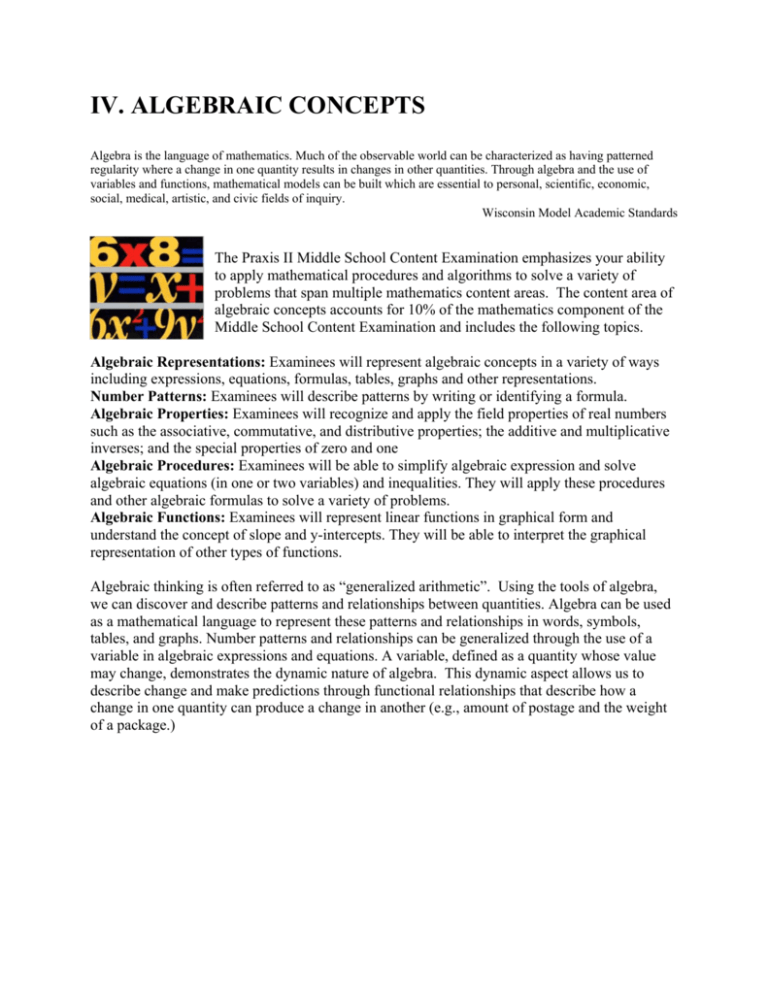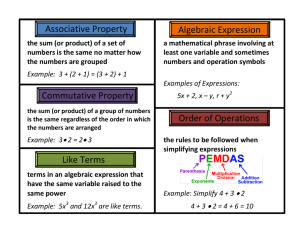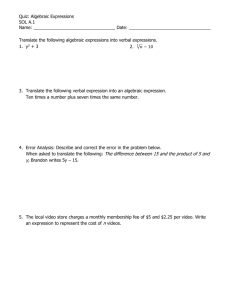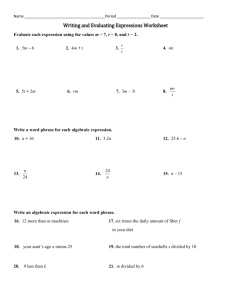iv. algebraic concepts - University of Wisconsin
advertisement

IV. ALGEBRAIC CONCEPTS Algebra is the language of mathematics. Much of the observable world can be characterized as having patterned regularity where a change in one quantity results in changes in other quantities. Through algebra and the use of variables and functions, mathematical models can be built which are essential to personal, scientific, economic, social, medical, artistic, and civic fields of inquiry. Wisconsin Model Academic Standards The Praxis II Middle School Content Examination emphasizes your ability to apply mathematical procedures and algorithms to solve a variety of problems that span multiple mathematics content areas. The content area of algebraic concepts accounts for 10% of the mathematics component of the Middle School Content Examination and includes the following topics. Algebraic Representations: Examinees will represent algebraic concepts in a variety of ways including expressions, equations, formulas, tables, graphs and other representations. Number Patterns: Examinees will describe patterns by writing or identifying a formula. Algebraic Properties: Examinees will recognize and apply the field properties of real numbers such as the associative, commutative, and distributive properties; the additive and multiplicative inverses; and the special properties of zero and one Algebraic Procedures: Examinees will be able to simplify algebraic expression and solve algebraic equations (in one or two variables) and inequalities. They will apply these procedures and other algebraic formulas to solve a variety of problems. Algebraic Functions: Examinees will represent linear functions in graphical form and understand the concept of slope and y-intercepts. They will be able to interpret the graphical representation of other types of functions. Algebraic thinking is often referred to as “generalized arithmetic”. Using the tools of algebra, we can discover and describe patterns and relationships between quantities. Algebra can be used as a mathematical language to represent these patterns and relationships in words, symbols, tables, and graphs. Number patterns and relationships can be generalized through the use of a variable in algebraic expressions and equations. A variable, defined as a quantity whose value may change, demonstrates the dynamic nature of algebra. This dynamic aspect allows us to describe change and make predictions through functional relationships that describe how a change in one quantity can produce a change in another (e.g., amount of postage and the weight of a package.) Topic A: Algebraic Representations h c A major objective in algebra is to learn to translate among words, tables, graphs and variables as shown in the example below. Words: Barbara has a snow shoveling business. She charges $4 for each hour that she shovels. Table: # Hours (h) Total Cost (c) Graph: 1 $4 2 $8 3 $12 4 $16 h c = 4h Variables: Let c = cost and h = number of hours. Algebraic Equation: c = 4h Algebraic expressions and equations both involve the use of variable(s) and allow us to describe patterns and relationships in a generalized manner. For example, the algebraic equation c = 4h means that the total cost that Barbara charges is related to the number of hours (h) she shovels. That is, the total cost is 4 times the number hours. Algebraic Expressions: An expression is a representation that involves variables and numbers and operations symbols. It is different than an algebraic equation because it does not contain the equality sign. Translating words into algebraic expressions and understanding those expressions is a critical component of the algebraic curriculum. The table below examines common translations. Operation + Addition Key Words The sum of 7 and a number. Ten more than a number A number increased by 6 Algebraic Expression 7 + y 10 + n m+6 - Subtraction 7 minus a number The difference of 5 and y 9 less than a number A number decreased by 6 7–n 5–y m–9 x–6 Operation x Multiplication Key Words Four times a number The product of -3 and a number 25% of a number Two-thirds of a number Algebraic Expression 4n -3y 0.25x 2/3m ÷ Division The quotient of a number and 5 20 divided by a number Combining Operations n ÷ 5 or n 5 20 ÷ m or Nine less than three times a number The quotient of a number increased by 5 and 7 The phone company charges $40 a month plus 17¢ per minute for long distance calls 20 m 3n – 9 n+5 7 40 + 0.17m Algebraic Equations and Inequalities: Once we learn how to translate phrases into expressions we can translate sentences into equations. Two algebraic expressions with the same value form an equation, symbolized with the equal sign “= “. Therefore, an algebraic equation is a statement of equality. In a mathematical sentence, the word “is” is translated into the equal sign “=”. Using the same key words above, we can translate the following sentences into algebraic equations using one or more variables. Inequalities are algebraic expressions that are related by the “less than (<)”, “less than or equal to (≤), “greater than (>)” or greater than or equal to (≥)”. Sentence The sum of 7 and a numbers is 15 Algebraic Equation 7 + y = 15 The sum of 7 and a numbers is greater than 7 + y > 15 15 The length (L) of a rectangle is three less than L = 2W – 3 twice its width (W). Twice the larger of two numbers is the quotient Let l = larger number and s = smaller number of three more than five times the smaller 3 + 5s 2l = number and 7. 7 Evaluating Algebraic Expressions, Equations, and Inequalities: To evaluate an algebraic expression, we can substitute a specific value for each variable and perform the indicated operations. For example, we can evaluate the expression 7 + y for y = 5 by plugging in 5 for y and performing the addition operation: 7 + 5 = 12. Evaluating expressions is a helpful tool for checking to see if we translated words into symbols correctly or filling in a table or making a graph that represents a numerical pattern or relationship. When we evaluate an equation or inequality, we are determining the truthfulness of a numerical sentence. For example, we could ask ourselves if y = 5, gives the correct solution to the equation 7 + y = 15. By plugging in y = 5, we see that 7 + 5 ≠ 15. In other words, y = 5 is not a solution to the equation 7 + y = 15. Note y = 8 is a solution to the equation since 7 + 8 = 15. We will use these fundamental skills to form and verify algebraic expressions and equations found in number patterns To practice translating words into algebraic expressions, equations and inequalities please visit the Variable Expression Learning Object or take the Translation Challenge. Topic B: Number Patterns Many people describe mathematics as the science of patterns. This is not surprising since patterns are all around us. In mathematics, we use the language of algebra to identify and generalize patterns. We can use these generalizations to predict the next number or object in the sequence or the 50th number. In mathematics, a sequence is a list of numbers or objects. Consider the sequence of numbers 4, 7, 10, 13, …. We call each number in the sequence a term. That is the first term (n = 1) is 4, the second term (n = 2) is 7, and so on. We can describe this sequence in words or an algebraic expression. We can also represent a sequence using tables or graphs. Words: Each term in the sequence is 4 more than the previous term. Algebraic Expression: Let n = term number, then this sequence is represented by 3n + 1. Graph and Table: 1 2 3 4 n Term number (n) 4 7 10 13 3n + 1 Term The sequence given by 4, 7, 10, 13, … is called an arithmetic sequence because each term is found by adding the same amount to each previous term. In other words, an arithmetic sequence is a sequence in which the difference between any two consecutive terms is the same. Another common type of sequence in mathematics is a geometric sequence. In a geometric sequence, each term is found by multiplying the same amount to each previous term. For example, the sequence given by 4, 8, 16, 32, … is a geometric sequence determined by multiplying by two to get to the next term. Problem solving with patterns often ask us to find the missing term in a sequence or to verify an expression for the given sequence. The two problems below demonstrate these types of problem solving skills. Look at the number pattern: 8, 15, 22, 29, … Problem 1: What is the next number in this in the pattern? a. 30 b. 35 c. 36 d. 41 Problem 2: Which expression represents the next number in the pattern, where n is the term number in the pattern? a. 8n b. 8n + 7 c. 7n + 1 d. 7(n + 1) For more practice with patterns, please visit the Number Pattern Learning Object or the Sequences Learning Object. Topic C: Algebraic Properties Addition and multiplication of real numbers exhibit a number of different properties. Using the language of algebra we can generalize these properties as algebraic rules and equations. The following tables represent these field properties for real numbers a, b, and c. Field Property for Addition 1. Closure: a + b is a real number. The sum of any two real numbers is a unique real number. Arithmetic Examples 5+2=7 1/5 + 2/3 = 13/15 2. Commutative Property: a + b = b + a. The order of the addends does not affect the sum. 3. Associative Property: (a + b) + c = a + (b + c). The grouping of addends does not affect the sum. 4. Additive Identity: a + 0 = 0 + a = a. The sum of any real number and 0 is that number. 5. Additive Inverse: a + (-a) = (-a) + a = 0. The sum of a real number and its opposite is 0. 5+2=2+5=7 1/5 + 2/3 = 2/3 + 1/5 = 13/15 (5 + 2) + 3 = 5 + (2 + 3) = 10 (1/5 + 2/3) + 1/3 = 1/5 + (2/3 + 1/3) 5+0=0+5=5 1/5 + 0 = 0 + 1/5 = 1/5 5 + (-5) = (-5) + 5 = 0 1/5 + (-1/5) = (-1/5) + (1/5) = 0 Field Property for Multiplication a x b = ab 1. Closure: ab is a real number. The product of any two real numbers is a unique real number. 2. Commutative Property: ab = ba. The order of the factors does not affect the sum. 3. Associative Property: (ab)c = a(bc). The grouping of addends does not affect the sum. 4. Multiplicative Identity: a x 1 = 1 x a = a. The product of any real number and 1 is that number. 5. Multiplicative Inverse: a x 1/a = 1/a x a = 1. The product of a real number and its reciprocal is 1. 6. Distributive Property of Multiplication Over Addition: a(b + c) = ab + ac To multiply a sum by a real number, multiply each addend by that number, then add the two products. Arithmetic Examples 5(2) = 10 1/5(2/3) = 2/15 5(2) = 2(5) = 10 1/5 x 2/3 = 2/3 x 1/5 = 2/15 (5x2) x 3 = 5 x (2 x 3) = 30 5x1 = 1x5 = 5 1/5 x 1 = 1 x1/5 = 1/5 5 x 1/5 = 1/5 x 5 = 1 2/3 x 3/2 = 1 5(2 + 3) = 5x2 + 5x3 = 25 To identify these properties in other examples, please visit the Properties of Real Numbers Learning Object. Topic D: Algebraic Procedures Consider the following problem: Mark is the younger brother of Mike who is two years older. Six less than four times Mark’s age is equal to three times Mike’s age. How old in Mark? In order to solving this problem, we must be proficient at performing algebraic procedures. Two common procedures are simplifying expressions and solving linear equations. Before we return to solving the task above, we will examine these types of algebraic procedures. Simplify Expressions: We use the field properties in Topic C, to simplify algebraic expressions. Often the goal of simplifying polynomial expressions is to combine like terms. To begin, we need some common terminology. A term in a polynomial expression can be a constant, a variable or the product of a number and variable(s). Here are some terms in a polynomial expression 5, 3x, 5y2, -2ab. Through addition, subtraction, or multiplication we can form polynomial expressions. The table below illustrates the ideas behind simplifying polynomial expressions. Combining Like Terms: Multiplying by a Constant: Multiplying Polynomials: Distributing the Negative: Factoring out the GCF: Factoring Polynomials: 3x2 – 2x + 5 – 3x + 4 – 2x2 = x2 – 5x + 9 2(3x – 2) = 6x – 4 (x + 1)(3x – 2) = 3x2 – 2x + 3x – 2 = 3x2 + x - 2 3x – (2x – 4) = 3x – 2x + 4 = x + 4 6x + 9 = 3(2x + 3) x2 + 7x + 12 = (x + 4)(x + 3) To practice these techniques, visit the Simplifying Algebraic Expressions Learning Object. Solving Linear Equations: In order to solve word problems, we must apply our skills in translating words into equations, as well as using the techniques above. Common word problems on the PRAXIS II examination are of two forms: linear equations in one variable and linear equations in two variables. A linear equation in one variable can be written in the form ax + b = c, where a, b, and c are real numbers (a ≠ 0). This type of equation is also called a first-degree equation because the greatest power on the variable is one. We often solve these types of equations by “undoing” the order of operations through the addition property of equality and the multiplication property of equality. These two properties state that “what we do to one side of the equation, we must do to the other side of the equation”. The goal of these procedures is to isolate the variable term on one side. See if you can follow the steps for solving the linear equation in one variable given by 4x – 2x – 5 = 4 + 6x + 3. Steps 4x – 2x – 5 = 4 + 6x + 3 2x – 5 = 6x + 7 2x – 5 = 6x + 7 +5 +5 2x = 6x + 12 2x = 6x + 12 -6x -6x -4x = 12 -4x = 12 ÷-4 ÷-4 Justification Combine Like Terms Addition Property of Equality (Add 5 to each side) Addition Property of Equality (Add -6x to both sides or subtract 6x from both sides) Multiplication Property of Equality (Multiply both sides by -1/4 or x = -3 divide both sides by -4) Check: 4(-3) – 2(-3) – 5 = 4 + 6(-3) + 3 -12 + 6 - 5 = 4 + (-18) + 3 -11 = - 11 Try to solve a word problem as a linear equation in one variable: Mark is the younger brother of Tom who is two years older. Six less than four times Mark’s age is equal to three times Tom’s age. How old in Mark? To practice solving word problems involving linear equations, visit the Story Problem Learning Object or the Subsets Learning Object. Topic E: Algebraic Functions Reflect back on Barbara’s snow shoveling business. She charges $4 for each hour that she shovels. If she shovels for 4 hours, she will charge $16. If she shovels for 7.5 hours, she will charge $30. In general, Barbara will charge more money for her services as the number of hours she spends shoveling increases. In other words the amount the Barbara charges for her services is a function of the number of hours she works. If we let the variable h represent the number of hours and let c represent the total cost of the job, then the rule for this function is given by c = 4h. We often call this type of equation a linear equation in two variables. We encounter many functional relationships every day. Here are a few more examples: • The number of wheels in a parking lot is a function of the number of cars. • The amount of postage on a first-class package is a function of the weight of the package. • The cost of filling up at a gas station is a function of the amount of gasoline you purchase. We can express each functional relationship by a rule or algebraic equation in two variables. This rule describes the relationship of a dependent variable (e.g., cost of filling up) as a function of the independent variable (e.g., amount of gasoline purchased). This rule can be also expressed in words, tables, graphs, or through function machines. Viewing a function as a machine provides insight into the dynamic nature of the rule. That is, we can investigate how the change in the independent variable (the input) elicits change in the dependent variable (the output). In algebra, we often chose x to represent the input variable and y to represent the output variable. Below is one example of function machine. The function rule given above by y = 2x + 1 can also be expressed in a table or as a graph. In problem solving tasks involving a functional relationships we are often given the input and output values and are asked to determine the algebraic rule. Which equation expresses the relationship between x and y as shown in the accompanying table and graph? a. y = x – 3 b. y = 3x – 5 c. y = 2x – 3 d. y = x + 1 The two functional relationships above represent linear functions. More specifically, these rules represent the slope-intercept form of the equation of line given by y = mx + b, where m is the slope and b is the y-intercept. The slope gives us an idea of the direction and steepness of the line. We can also view the slope as the “rise over run”. In the linear equation y = 2x + 1, the slope is m = 2 = 2/1, which means a rise of 2 units for every run of 1 unit. That is, as x increases by 1, y increases by 2. The y-intercept, b, is the value for which the graph crosses the y-axis. At this point, the x-coordinate is x = 0. From a graph or table, the equation of a line can be found by determining the slope and its y-intercept. To find the slope, we need two points (x1, y1) and (x2, y2) on the graph or in the table The slope is defined as the change in the y-coordinates divided by the change in the y − y1 . corresponding x-coordinates as shown in the formula m = 2 x 2 − x1 By examining slopes of two lines we can determine whether those lines intersect or not. Two non-intersecting lines are called parallel and these lines must have the same slope. Two lines that intersect at a right angle (90 degrees) are called perpendicular and these lines have slopes that are opposite reciprocals. That is, a line perpendicular to y = 2x + 1 is given by y = -1/2x + 5. To practice these skills regarding the functions and the slopes and y-intercepts of linear equations, please visit the following learning objects. • Points on a Line • XY Plane • Perpendicular Lines • Step Functions






